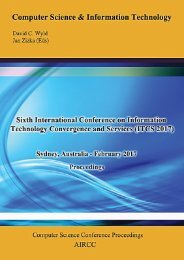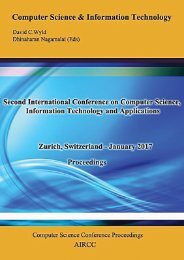CoSIT 2017
Fourth International Conference on Computer Science and Information Technology ( CoSIT 2017 ), Geneva, Switzerland - March 2017
Fourth International Conference on Computer Science and Information Technology ( CoSIT 2017 ), Geneva, Switzerland - March 2017
Create successful ePaper yourself
Turn your PDF publications into a flip-book with our unique Google optimized e-Paper software.
100 Computer Science & Information Technology (CS & IT)<br />
encryption mechanism must also increase. For example, RFC7935 states that the RSA key pairs<br />
for use in public key infrastructure (which is a framework for what is called one-way function)<br />
must be using at least 2048-bit [17]. Therefore, the strength of encryption algorithms for a oneway<br />
function is based on the computing power and time required to decrypt the message.<br />
8.3. Initial Burden for all Parties Involved<br />
All parties involved (e.g., financial institutions, third-party companies, end-users) would need to<br />
make changes to their current processes, practices, and habits. For instance, financial institutions<br />
would need to modify their online accounts and systems to use the new protocol and offer new<br />
account granular access control; third-party companies must make changes to their current<br />
informational retrieval processes, as well as follow the specification of the new protocol for user<br />
authentication; the end-users would need to request alternate access credentials from their<br />
financial institutions for their accounts, provide the vendor information of the third-party, as well<br />
as change their full-access login credentials if they have already exposed that to others.<br />
9. RELATED WORK<br />
In this section, we will discuss related work in the area of authenticating users’ access to online<br />
services.<br />
9.1. OAuth<br />
A related work to our research is the OAuth authorization framework. OAuth allows<br />
authentication of a user without exposing their account credentials to a third-party provider over<br />
HTTP protocol [18]. The main concept behind OAuth is that, when a user is trying to login to a<br />
third-party website, they can use their accounts’ username/password from one of the major<br />
companies (e.g., Facebook, Twitter, LinkedIn) to authenticate themselves with a third-party<br />
company. With this method, users no longer have to reveal their login credentials with third-party<br />
companies. Currently, the deployments of OAuth framework have had limited exposure. This<br />
model has not been widely accepted as the alternative to hiding and protecting account credentials<br />
from third-party companies. As a result, OAuth currently suffers from penetration and adoption<br />
challenges, as well as privacy and security concerns.<br />
9.2. Application Programming Interface<br />
Another related work is where companies provide mechanisms for information retrieval and<br />
manipulation from their systems. This type of access is performed via application permission<br />
model [19] provided by Application Programming Interface (API) (e.g., Twitter API) [20]. This<br />
method is used to read, write, perform information retrieval and data mining to access and harvest<br />
data from companies (e.g., Twitter, Google) that support those APIs. The API may use OAuth<br />
technology as its underlying authorization mechanism to authenticate the request. Due to the<br />
nature and exposure of information provided with this model, it has its limit where sensitive<br />
information, security, and privacy are concerned.<br />
10. CONCLUSIONS<br />
The ubiquity of the Internet has increased the potential exploitation of security weaknesses and<br />
vulnerabilities of our financial institutions. Users are sharing their full access accounts’<br />
credentials with third-party companies and need to be wary of sharing this sensitive information<br />
with others, especially when those credentials can be used by others to execute transactions on





